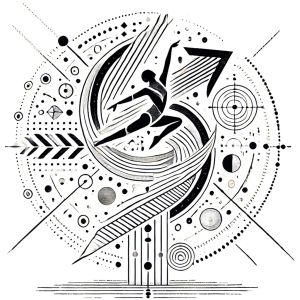InnerMotion – The Guidebook – Move Through Space

Dancing through space elevates your experience, turning isolated movements into a flowing narrative that engages the environment around you. It’s like switching from a still photo to a dynamic film, bringing energy, dimension, and vitality to your expression. As you move, it often feels like your inner emotional state transforms, as if the act of changing spaces brings a shift in energy within you. This movement not only enhances your connection to the environment but also cools your body with the flow of air, adding a refreshing physical element. Embracing this technique enhances your physical engagement, sharpens your spatial awareness, and transforms your dance into a more immersive and expressive experience.
Dancing in Spaciousness
- Explore the Entire Floor: Take advantage of open areas by traveling across the dance floor. Use expansive, flowing movements to carry you from one side to the other, creating a sense of drama and storytelling in your dance. Incorporate twirls, glides, or dynamic leaps to further enrich your movement as you traverse the space.
- Incorporate Directional Changes: Avoid staying in linear patterns. Add spontaneity by moving diagonally, zigzagging, or spinning in unexpected directions. This variation keeps your dance dynamic and prevents it from feeling predictable.
- Engage with the Periphery: Don’t confine yourself to the center of the dance floor. Explore the edges, corners, or even spaces near walls. These less-traveled areas can inspire new movements and give your dance a sense of discovery.
- Use Your Surroundings: Let the environment inspire your movements. Lean against a wall, spin around a pole, or react to changes in floor texture. Each element of your surroundings can become a part of your dance, adding creativity and a sense of connection to the space.
- Vary Your Levels: Incorporate vertical dimension into your dance by shifting between high and low movements. Reach upward with extended arms to evoke a sense of elevation and energy, or sweep low to the ground with bends or lunges to create contrast.
- Play with Speed and Momentum: Experiment with how quickly or slowly you move across the space. Use sudden bursts of energy to create dramatic moments or slow, deliberate steps to build tension and elegance.
Dancing in Crowdedness
- Spot Dancing: Find a spot and make it your own. Rotate around it, focusing on turns and pivots that require minimal space but offer enough expressive potential.
- Small, Contained Movements: When space is limited, focus on smaller, more contained movements. A gentle lean or a soft pivot can create a sense of movement without requiring much room. Small, deliberate steps allow you to navigate through the crowd while staying connected to the rhythm.
- Awareness and Respect: Be hyper-aware of others around you. Maintaining a smaller dance footprint can help avoid collisions and shows respect for the shared environment.
- Own the Space: Use your arms and hands to project your presence outward, creating an expressive connection that communicates confidence and ownership of the space around you without physically expanding.
- Connect with Others: Use the opportunity to engage with other dancers close by through eye contact, synchronized movements, or even non-verbal communication, turning the crowded space into an interactive dance experience.
- Make a Circle: If you're with friends, forming a circle and dancing inward can create a shared space that reduces the feeling of crowding around you. In this way, a small space is used optimally, while also enhancing group dynamics and a sense of connection.
General Tips
- Continuous Flow: Whether in open or crowded spaces, keep your movements fluid and continuous. Even when stationary, you can express movement through the flow of your arms, the tilt of your head, or the sway of your body.
- Spatial Awareness: Always be mindful of your surroundings and the people around you. This awareness not only prevents accidents but also helps you navigate and adapt your dancing to the available space.
- Be Playful: Experiment with spontaneous movements, improvisation, and interacting with the environment around you. Playfulness keeps your dance fresh and helps you respond creatively to changing space dynamics.
By exploring these suggestions, you can enhance your ability to dance in any setting. Moving through space, even in the most restricted environments, becomes a creative opportunity to add depth, variety, and personal expression to your movements.